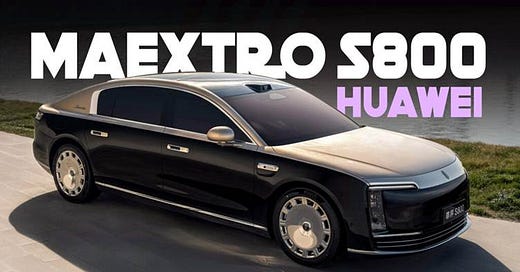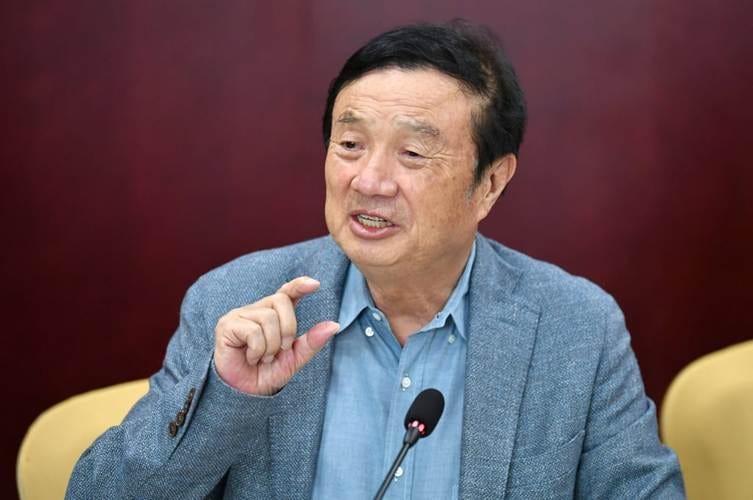Huawei is transforming and building an unparalleled AI tech stack
How US sanctions have boomeranged, and Huawei is not just breaking through, it is transforming into an AI powerhouse
Huawei is transforming in front of our eyes.
When the US and Canada detained Meng Wanzhou, the CFO of Huawei Technologies and the founder’s daughter in 2018, Huawei was the world leader in telecom and smart phone production (it was ranked No. 1 in global sales that year ahead of Samsung and Apple).
While it was a massive and successful business, Huawei was embedded in the global tech supply chain – it was one of the largest buyers of TSMC chips, Android OS, EDA software from Synopsis, and paid billions every year in royalties for intellectual properties owned by global companies.
However, the US regime started to make unsubstantiated national security risk claims about Huawei and imposed unprecedented sanctions on the company – banning sales of its telecom gears in vassal states and denying chip and software access. The goal was clear – the US regime wanted to destroy the Chinese tech powerhouse in a critical industry.
No companies in history have been under such all-out attack by the reigning global hegemon.
When the French nuclear company Alstom was accused of bribery by the US regime (really for outcompeting US companies), it was forced to sell to GE and its CEO imprisoned for years. Read the fascinating book “The American Trap: My Battle to Expose America’s Secret War Against the Rest of the World” by the jailed CEO Frederic Pierucci. https://www.goodreads.com/book/show/51202437-the-american-trap
When then world-leading chip maker Toshiba was targeted by the US regime for being too successful in a critical industry, it had to sell the prized memory chip business to US-based Bain Capital and make room for Intel, Micron, and Analog Device.
However, the arbitrary weaponized US sanction regime completely failed to stop Huawei’s rise.
After 5 hard years of revenue decline, Huawei turned around its core business and recorded historical sales and profits since 2023. Rather than having its business truncated, Huawei has vastly expanded its footprint and has entered numerous new tech verticals.
Today, Huawei retains its No. 1 position in the global telecom market. It has taken back the lead in China’s smart phone market, the world’s largest by a big margin. Huawei is also the world leader in the wearables market such as smart watches.
Huawei has launched the Harmony OS to replace Android and Windows as the operating system for all its devices. Harmony OS is also powering other Chinese tech products. By Oct 2024, it is run on over 1 billion devices globally.
Huawei has entered the electric vehicle market with multiple joint projects with many Chinese EV makers. It is not just providing software to EV makers but researching battery and autonomous driving technologies.
On May 30 2025, Huawei launched the ultra high-end Huawei Maextro S800, which Carscoops described as “looks like someone put a Maybach, a Rolls and a Porsche in the blender”. (https://www.carscoops.com/2024/11/maextro-s800-ev-is-a-chinese-maybach-rival-from-huawei-and-jac/ )
The Maextro S800 doesn’t just look great and has a 1,006 horsepower electric engine; its starting price is a modest $98,000 in China.
Huawei has invested in Chinese companies making DUV and EUV lithography machines, chip makers, and EDA software developers. Huawei has built AI data centers and is providing AI applications for the auto, mining, construction, and infrastructure industries.
Today’s Huawei is Apple, Nvidia, Ericsson, TSMC, ASML, Qualcomm, Google, and Tesla rolled into one.
Huawei’s R&D budget in 2024 reached $25 billion, or 21% revenue. In the past decade, it spent $175 billion on R&D. The company employs over 110,000 engineers and scientists for research, 55% of its total workforce. In Europe alone, Huawei has 28 research centers.
It’s virtually impossible to cover all the tech swim lanes Huawei is competing in today. The unauthorized Eva Dou biography of the firm “The House of Huawei” virtually became outdated the minute it rolled off the press in January 2025.
Though not one for the techies, I still recommend a read because of the incredible history the book covered.
Most impressively, Huawei has built a full AI stack – a feat no company in the world has achieved including Nvidia or TSMC, a fact that Jensen Huang, Nvidia’s CEO, readily acknowledged to the press.
Huawei’s chip design division, HiSilicon, is a global leader and competes with Nvidia and Qualcomm. Where Nvidia offers CUDA to developers in its ecosystem, Huawei has built a software platform known as compute architecture for neural networks (CANN).
(Huawei founder – Ren Zhengfei https://en.wikipedia.org/wiki/Ren_Zhengfei )
Huawei recently rolled out its marque AI chip Ascend 310B and the Ascend-powered advanced data center architecture CloudMatrix 384.
In a high-profile test, CloudMatrix 384, along with the serving solution CloudMatrix-Infer, outperformed the Nvidia H800 GPU-based SGLang fast-serving framework for large language models (LLMs), on both the inference and decoding phases, in running DeepSeek’s R1 reasoning model.
The CloudMatrix 384 system is a specialized AI supernode that is purpose-built for handling extensive AI workloads. It consists of 384 Ascend 910C neural processing units (NPUs) and 192 Kunpeng server central processing units (CPUs), interconnected through a unified bus providing ultra-high bandwidth and low latency.
The highly efficient architecture pushes the boundaries of AI system performance and is projected to reshape the foundation of AI infrastructure.
According to an analysis by chip research firm SemiAlaysis, “Huawei is a generation behind in chips, but its scale-up solution is arguably a generation ahead of Nvidia and AMD’s current products on the market.”
The secret of Huawei’ superior performance is that although Huawei chip technology still lags behind Nvidia’s topline offering, using methods such as stacking and clustering has resulted in computing performance comparable to the most advanced systems in the world.
In data center environment, a single chip’s performance is not as important as the combined power of a group of chips working together in parallel. Building and optimizing large-scale data center systems requires complex networking expertise – the very field that Huawei is the undisputed global leader as the world’s top telecom equipment provider.
Jensen Huang seemed to agree in an interview during the VivaTech conference in Paris earlier this month. Huang said, “AI is a parallel problem, so if each one of the computers is not capable … just add more computers…in China, they have plenty of energy, they’ll just use more chips.”
This is a point I have written in earlier essays – a key advantage China has over the US in AI development is its power generation capacity, more than twice that of the US.
Huang warned that Huawei was in a position to take over the semiconductor business in China and beyond. “If the United States doesn’t want to participate in China, Huawei has got China covered. Huawei also has got everybody else covered.”
The US ban of Nvidia AI chips to China has worked in slowing AI development in China, but it has also accelerated China’s push to indigenise every step of advanced AI chipmaking.
With its deep pool of AI talents – overly 50% top global AI researchers are Chinese, it’s a matter of time that China will close the gap and overtake the US.
Meanwhile, Nvidia is no longer considered a reliable source of AI chips, even if the company is allowed to sell in China again.
Jensen Huang told reporters during the Computex Expo in Taipei in May, “All in all, the export controls were a failure. The facts would suggest it.”
Huawei won’t be what it is today without the US tech sanctions.
According to a survey last year, Huawei is ranked the No. 1 most valuable brand in China in any industry. The brand is associated with national pride and technological confidence. Many Chinese feel obliged to buy Huawei products as a default choice to support domestic technology.
It's no exaggeration to call Huawei “China’s most important company”, no small thanks to the sanctions from the short-sighted belligerent US regime.






I'll probably write if something interesting comes up. I share your sentiment the world would be a much better place if nations collaborate and work together to improve the lives of all rather than the division and hostility today. I think the ruling class in the west has a vested interest to set things up in a way that they can manipulate for their private gains. President Xi's idea of a common community for mankind is an aspiration future generations hopefully can move towards.
Good article. I had a Huawei-made Google Nexus phone years ago and it was great. Can't have a Huawei now here though.
It's not just tech and sanctions that the US uses to limit competition. In vehicles there's the notorious chicken tax to protect US-branded (mostly made in Mexico now) trucks, in the 1980s we hobbled the Japanese motorcycle manufacturers to protect failed Harley-Davison.
Today in HVAC we are having to use a new refrigerants again, because Honeywell's patents on R410 & R134 expired. Instead of using the Toshiba-invented, patent-free R32 refrigerant that is more efficient and environmentally better (which the rest of the world uses), we in the USA are forced to use a Honeywell-patented blend of royalty-free R32 with a bit of Honeywell R1234 thrown in JUST so that Honeywell can get royalties.
American normies think capitalism=free markets, but in practice American markets are less "free" than even "communist" China. It's all so tiresome; all we can do is laugh, lest we despair.